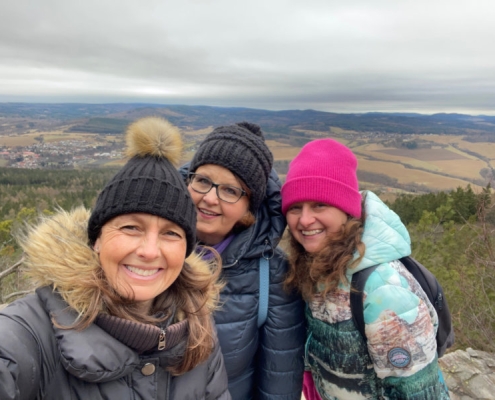Healing Through Connection: Building a Community for Women in Midlife
Midlife often brings unique challenges—shifting relationships, health changes, career transitions, or children leaving home. While these changes can be overwhelming, one of the most effective ways to navigate them is by fostering meaningful connections. Building a supportive community not only provides emotional support but also serves as a source of inspiration, empowerment, and healing.
In this guide, we’ll explore how women in midlife can build strong communities and the tools, strategies, and examples to make it happen.
Why Community Matters in Midlife
The Emotional Benefits of Connection
- Reduced Isolation: Many women experience loneliness in midlife due to life changes, but community helps combat feelings of isolation.
- Shared Experiences: Connecting with others facing similar challenges fosters understanding and empathy.
- Boosted Mental Health: Studies show that strong social connections reduce anxiety, depression, and stress.
- Inspiration and Growth: Surrounding yourself with a supportive network encourages personal development and resilience.
How Midlife Challenges Make Community Essential
- Empty Nest Syndrome: With children leaving home, many women feel a loss of purpose.
- Career Shifts: Changing or winding down careers can lead to a loss of daily social interactions.
- Health Transitions: Menopause and aging-related health concerns can feel isolating without peers to relate to.
- Reassessing Relationships: Changes in friendships, romantic relationships, or familial roles often highlight the need for new forms of connection.
Strategies for Building a Supportive Community
1. Leverage Existing Relationships
Your current network may already hold opportunities for a deeper connection.
Reconnect with Old Friends
- Reach out to childhood, college, or former work friends via social media or email.
- Organize a reunion or a casual meet-up over coffee or lunch to rekindle relationships.
Strengthen Family Ties
- Plan regular family check-ins through video calls, especially if they live far away.
- Start new traditions like monthly family dinners or game nights.
2. Join Local Groups and Activities
Engaging in local activities helps you meet people with similar interests and values.
Examples of Local Groups
- Book Clubs: Join or start a group where women discuss literature or memoirs about midlife experiences.
- Fitness Classes: Attend yoga, Pilates, or water aerobics tailored for midlife women.
- Volunteering Opportunities: Work with organisations that align with your passions, like animal shelters, food banks, or mentorship programs.
Tools to Find Local Groups
- Meetup: Search for interest-based meetups in your area.
- Community Boards: Check libraries, community centers, or local cafes for event listings.
- Facebook Events: Look for local workshops, fairs, or wellness events.
3. Create Your Own Support Group
If you don’t find a group that meets your needs, consider starting your own.
Steps to Create a Group
- Define the Purpose: Decide whether your group will focus on emotional support, shared hobbies, or professional networking.
- Choose a Format: Host in-person meetups, virtual gatherings, or a mix of both.
- Promote Your Group: Use tools like Eventbrite, Facebook, or Instagram to invite participants.
- Set Guidelines: Ensure a respectful, inclusive, and supportive environment for all members.
Ideas for Group Activities
- Organize a monthly potluck dinner with themed discussions (e.g., health, travel, or self-care).
- Start a skills-sharing group where members teach each other new hobbies or crafts.
- Create a walking club to combine fitness with connection.
4. Engage Online
The digital age has made it easier than ever to find and build communities.
Join Online Groups
- Social Media Communities: Look for Facebook or LinkedIn groups focused on midlife topics, such as “Women Thriving in Midlife” or “Menopause Wellness.”
- Specialized Platforms: Websites like Mighty Networks or Circle host niche communities for women in transition.
Create Your Online Presence
- Blog or Vlog: Share your journey, insights, and experiences with a wider audience.
- Virtual Events: Host online workshops or discussions on topics relevant to midlife women.
- Instagram and TikTok: Use these platforms to find and engage with relatable influencers or groups.
Benefits of Online Communities
- Connect with women worldwide who share your challenges and goals.
- Participate in discussions at your convenience, fitting into your schedule.
5. Seek Professional Support Networks
Not all connections need to be social—some can be professional.
Examples of Professional Support
- Therapy Groups: Join group therapy sessions specifically for midlife women.
- Mentorship Programs: Partner with or mentor other women navigating similar transitions.
- Workshops and Retreats: Attend events focusing on personal growth, wellness, or career development.
Tools for Professional Networks
- Therapy Directory: Use resources like Psychology Today to find local group therapy options.
- Event Platforms: Search for retreats or workshops on platforms like Eventbrite or WellnessLiving.
- Professional Organisations: Join associations or networks catering to women in specific industries or life stages.
Moving Forward: The Power of Connection
Building a community in midlife is not just about finding support—it’s about fostering joy, resilience, and empowerment. Whether you’re reconnecting with old friends, joining local groups, or creating a new circle from scratch, every step you take towards connection is a step toward healing.
Remember, the relationships you cultivate in midlife can bring renewed purpose and happiness. So reach out, share your story, and invite others to walk this journey with you. Together, you can create a community that uplifts and empowers every member.









